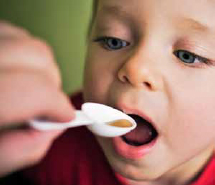Avoid Medication Aisle Confusion

By Dr. Annie Baker
“My child was running a fever and I stopped by the store to pick up some medicine. The medicine counter is overwhelming. How do I know which product to choose where there are so many options? My wife said he had a fever, but he also has a runny nose.”
The choices in children’s medicine can be daunting. Yet it is important to choose the right medication. There are numerous brands and the packaging can say many different things. It is important to treat infants and young children for the correct symptoms with the correct dosage.
When choosing a child’s over the counter medication you should always do two things: read the active ingredients and determine the correct dosage amount for your child.
Determine which product you need based on the active ingredient
The most important item to look for on the box is the active ingredient. You can almost ignore all the other claims on the box. The active ingredient is the portion of the medication that actually helps your child and is usually listed on the front of the box as well as on the side.
It is important to prevent double dosing young children with medication. If a child is receiving acetaminophen in one product, he does not need a separate dose of Children’s Tylenol. Double dosing can cause side effects of overdosing.
Determine the correct dosage for your child
The next important item is the strength. This is the amount of the active ingredient and is what the dosage for your child is based on. The strength is always listed in milligrams (mg) and for most children’s medications, it is in a liquid form per milliliters (ml). It is very important to get your child’s dosage correct. The way the medicine states dosage can sometimes be confusing. Please spend the time to correctly identify your child’s correct dosage.
- Example: Children’s Motrin
- Active ingredient is Ibuprofen 100mg/5ml.
- Important fact is that 5ml = 1 teaspoon
- Check product package to determine dosage by weight and age.
Common Active Ingredients
Fever and Pain Reducers
There are two main fever reducers that come in a variety of brands.
Acetaminophen (also known as Tylenol, Pedicare, Feverol, etc.) This may be used in children to help with fever or pain. This medication should never be given more than every 4-6 hours. Be careful with combination medication as acetaminophen is often an ingredient and can led to overdose if other medications are given along with it.
Ibuprofen (also known as Motrin or Advil) This medication can be used for children over the age of 6 months and should not be given more frequently than every 6 hours. You do not want to give Ibuprofen at the same time as acetaminophen. Often doctors will suggest for high fevers that you may alternate acetaminophen and ibuprofen at three hour increments, still allowing for them both to be six hours between the dose.
Cold Medications
A general consensus amongst pediatricians is that we often do not recommend cough medications for children, as a cough is usually a symptom of an underlying problem. Nasal congestion and runny noses are often treated best with good nasal saline irrigation and suctioning.
When nasal saline and suctioning is not enough, a pediatrician may recommend an antihistamine to treat allergy symptoms, or a decongestant to help stuffy, congested noses.
Antihistamines
Diphenhydramine HCL (also know as Benadryl) is used frequently to help with runny noses and allergy like symptoms. This is a wonderful medication to have on hand for any type of allergic reactions, such as bee stings or food allergy. It can be used in all ages with appropriate dosages and given every 4-6 hours.
Loratadine (also known as Claritin), used for runny nose & allergy symptoms, is slower acting and only given once a day. Usually not recommended below 2 years of age.
Cetrizine (also known as Zyrtec), used for runny nose & allergy symptoms, is similar to Claritin in that it is given once a day and usually for children over 2 years of age.
Decongestants
Pseudophedrine (also known as Sudafed), is used to help with nasal congestion. It may be given to young children although many pediatricians will recommend nasal saline irrigation and suctioning before medications for nasal stuffiness.
You should always call your pediatrician for advice and recommendations.









